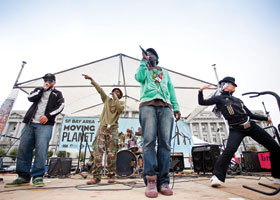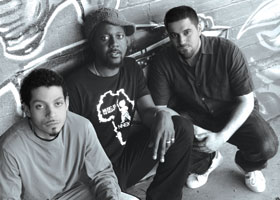I Am the Bee

New Bedford, Massachusetts, does not seem a likely home for a new wave of environmental art. In the nineteenth century, this harbor town served as the home port for much of the nation’s whaling fleet. Those bloody hulls, combined with the brownfields and empty quays that litter New Bedford today, have left the place a gritty reputation.Tem Blessed, a New Bedford resident and leading voice of the emerging genre of green hip-hop, aims to turn that reputation on its head. He and a small but street-hip caucus of artists from cities like New Bedford and Oakland, California, are forging eco-themed music that charts a much different future.
 An immigrant from Cape Verde, Blessed’s real name is Temistocles Ferreira. In recent songs, he has rapped about bringing green jobs, alternative energy and better air quality to the ‘hood. One of his better-known tracks is about bees, specifically, colony-collapse disorder. His track called “I Am the Bee,” released in 2009, broadcasts the plight of these pollinators:
An immigrant from Cape Verde, Blessed’s real name is Temistocles Ferreira. In recent songs, he has rapped about bringing green jobs, alternative energy and better air quality to the ‘hood. One of his better-known tracks is about bees, specifically, colony-collapse disorder. His track called “I Am the Bee,” released in 2009, broadcasts the plight of these pollinators:
Chorus: I am the bee:
Pollinate truth if you choose to see,

Pollinate the youth to truly be free,Pollinate love, let’s all agree:
I am the bee.”
Set against lushly looped strings, the song tackles more than just bee problems. It’s also about the power of individual relationships to slowly undo the tide of environmental destruction. In other words, if I can “pollinate” you, you can do the same for someone else.Green hip-hop draws on the same hardscrabble inner-city neighborhoods long plagued by drugs and violence. For instance, an artist/activist called DJ Cavem (real name: Ietef Vita) hails from Denver’s Five Points neighborhood. Cavem (djcavem.com) puns on this history with the title of his recent track “Wheatgrass,” as if to say, “Yeah, we’re into ‘grass’ here—the juicing kind.”
 The video for “Wheatgrass” (found on YouTube, as are all the songs mentioned) opens with Cavem strolling through a defunct grocery store. It looks like a scene from the old Soviet Union: empty shelves, no bread. He intersplices these images with photos of flourishing cabbages and white eggplants. “We must cultivate the earth!” Cavem yells, and that’s an order.
The video for “Wheatgrass” (found on YouTube, as are all the songs mentioned) opens with Cavem strolling through a defunct grocery store. It looks like a scene from the old Soviet Union: empty shelves, no bread. He intersplices these images with photos of flourishing cabbages and white eggplants. “We must cultivate the earth!” Cavem yells, and that’s an order.
Green hip-hop is not all bees and tomatoes. A strain of righteous anger runs through many of the songs. In “Work for Youth,” DJ Cavem gives listeners a survivalist ultimatum: “You’re telling me you can’t grow your own food. But if the shit shut down, tell me, what would you do?” Not a comfortable question for anyone without a fully stocked backyard bunker.
This ire is especially pronounced on Earth Amplified, a richly musical 2010 album created by Ashel “Seasunz” Eldridge and collaborator J. Bless. Seasunz lives in Oakland, a hive of green hip-hop where Tem Blessed also spent time. A track called “Global Warning” attacks the motives of the companies that sponsor “green” initiatives: “They don’t see people, just profits and losses. They don’t give a damn about the trees or the dolphins.
And in “Food Fight,” Seasunz spotlights the magnitude of the hunger in urban neighborhoods:
Poor diets kill more brothers than pistols.
We fight for our lives like Michael Vick’s pit bulls.
Dog eat dog, America eats the young.
We die from ‘beef,’ more from the meat than the gun.”
To compare hungry inner-city residents with the scarred mutts of Michael Vick: that’s palpable anger. As provocative as green hip-hop is at its best, it may ultimately be judged—like any other kind of activism—on its results. Will these songs inspire new gardens, healthier diets and community revitalization? Or will they flicker and fade like so many radio singles?
Meanwhile, mainstream hip-hop has started to dabble in things environmental. In the last two years, two of its biggest stars, Drake and Wiz Kalifa, have participated in a “Green Carpet Tour” of college campuses via biodiesel bus. During the tour, they encouraged students to recycle, buy local foods and vote.

